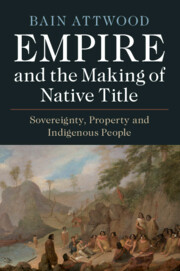Book contents
- Empire and the Making of Native Title
- Empire and the Making of Native Title
- Copyright page
- Dedication
- Contents
- Acknowledgements
- Abbreviations
- Principal Players
- Maps
- Introduction
- 1 Claiming Possession in New Holland and New Zealand, 1770s–1820s
- 2 Batman’s Treaty and the Rise and Fall of Native Title, 1835–1836
- 3 The South Australian Colonisation Commission, the Colonial Office and Aboriginal Rights in Land, 1834–1837
- 4 Protection Claims and Sovereignty in the Islands of New Zealand, 1800–1839
- 5 Making Agreements and a Struggle for Authority, 1839–1840
- 6 The Land Claims Commission and the Return of the Treaty, 1840–1843
- 7 A Colony in Crisis and a Select Committee, 1843–1844
- 8 The Retreat of the Government and the Rise of the Treaty, 1844–1845
- 9 The Making of Native Title, 1845–1850
- Conclusion
- Appendix: The English Text of the Treaty of Waitangi
- Bibliography
- Index
1 - Claiming Possession in New Holland and New Zealand, 1770s–1820s
Published online by Cambridge University Press: 03 July 2020
- Empire and the Making of Native Title
- Empire and the Making of Native Title
- Copyright page
- Dedication
- Contents
- Acknowledgements
- Abbreviations
- Principal Players
- Maps
- Introduction
- 1 Claiming Possession in New Holland and New Zealand, 1770s–1820s
- 2 Batman’s Treaty and the Rise and Fall of Native Title, 1835–1836
- 3 The South Australian Colonisation Commission, the Colonial Office and Aboriginal Rights in Land, 1834–1837
- 4 Protection Claims and Sovereignty in the Islands of New Zealand, 1800–1839
- 5 Making Agreements and a Struggle for Authority, 1839–1840
- 6 The Land Claims Commission and the Return of the Treaty, 1840–1843
- 7 A Colony in Crisis and a Select Committee, 1843–1844
- 8 The Retreat of the Government and the Rise of the Treaty, 1844–1845
- 9 The Making of Native Title, 1845–1850
- Conclusion
- Appendix: The English Text of the Treaty of Waitangi
- Bibliography
- Index
Summary
I argue that imperial agents treated legal concepts as a resource rather than a script for claiming possession of overseas territories, and did so in order to make vague claims to legitimacy vis-à-vis their imperial rivals rather than make strictly legal claims. I have found no evidence to suggest that James Cook claimed possession of New Holland on the grounds of terra nullius, res nullius or occupation. It is more likely that Cook relied upon two other legal concepts: discovery and possessio. Cook’s claim-making was primarily done with a European audience in mind rather than a local one, that it was concerned with staking a preliminary claim, and that his claim-making did not determine how questions about sovereignty or title in land were to be treated later. We need to focus on the sequence of events that began with the encounters between Cook’s party and the Aboriginal people, and the perceptions that Cook and Banks subsequently formed of the natives. After the colony was planted, the British government never saw any need to negotiate with the local people for cession of sovereignty or the purchase of land because it was relatively well-armed and encountered no powerful rival sources of power.
- Type
- Chapter
- Information
- Empire and the Making of Native TitleSovereignty, Property and Indigenous People, pp. 14 - 42Publisher: Cambridge University PressPrint publication year: 2020



